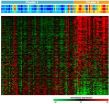(Press-News.org) Melanoma is particularly dangerous because it can form metastases in vital organs such as the lungs, liver or brain. UV radiation is considered to be the most significant triggering factor. An interdisciplinary team of researchers from the University Hospital and the LIMES Institute of the University of Bonn has now discovered that sunburns contribute to the development of this malignant disease not only through direct alteration of pigment cell genomes but also indirectly through inflammatory processes in the surrounding tissue. The results are now being published online in the renowned journal "Nature".
According to predictions from the Robert Koch Institute, approximately 20,000 people in Germany will develop malignant melanoma in 2014. More than 2500 of those affected will die from metastases to internal organs. "The inflammatory reaction of the skin after severe sun exposure promotes the early migration of melanoma cells along vessels within the body," says Prof. Dr. Thomas Tüting, professor of Experimental Dermatology at the University of Bonn Hospital and leader of the study team.
Melanoma cells migrate along blood vessels
To understand the development and early metastasis of malignant melanoma, the researchers developed experimental models in mice which allowed them to investigate the effect of inflammatory responses following UV exposure. "We repeatedly observed increased melanoma metastases in the lungs of UV-irradiated mice," reports the dermatologist Dr. Evelyn Gaffal. Analyses of melanoma tissue sections revealed the spread of tumor cells along blood vessel surfaces in inflamed skin. Using modern methods of fluorescence and electron microscopy, the researchers observed a close association between melanoma cells, inner blood vessel walls and immune cells, especially neutrophils.
Activated neutrophils pave the way for melanoma cells
Further experiments showed that neutrophils play an important role in metastasis. They are attracted by alarm signals emitted by UV-damaged keratinocytes in the epidermis. The use of special mouse strains which lack important molecules required for the activation of innate immune defense shed light on the underlying signaling pathways.
Inflammatory mediators promote melanoma cell motility
Researchers in the LIMES Institute of the University of Bonn developed new experimental methods to investigate the interaction between melanoma cells and cells of the inner blood vessel walls, known as endothelial cells. In doing so, they observed that melanoma cells can migrate particularly effectively on blood vessel surfaces. "Melanoma cells increase their motility in an inflammatory environment," says Prof. Dr. Waldemar Kolanus.
Further investigations with human melanoma cells and modern genomic methods provided insights how inflammatory mediators stimulate melanoma cells migration. "During embryonic development pigment cell precursors travel long distances along blood vessels in the body in order to reach their final destination in the skin. These migratory programs are erroneously reactivated in melanoma cells by inflammation," says Prof. Dr. Michael Hölzel from the Institute of Clinical Chemistry and Clinical Pharmacology in Bonn.
Important insights for new treatment strategies
"Our findings may explain why patients with superficially ulcerated melanomas and neutrophil infiltration frequently develop organ metastases" says Prof. Tüting. The researchers hope to develop new forms of targeted therapy in the future which specifically interfere with inflammatory signaling cascades and inhibit the migration of melanoma cells on the surfaces of blood vessels. The interdisciplinary cooperation between different research groups in Bonn within the Collaborative Research Center 704 and the Excellence Cluster ImmunoSensation provide an excellent basis for such ambitious projects.
INFORMATION:
Publication: Ultraviolet-radiation-induced inflammation promotes angiotropism and metastasis in melanoma, Nature, DOI: 10.1038/nature13111
Contact information for journalists:
Prof. Dr. Thomas Tüting
Senior Physician at the Department of Dermatology and Allergology and Director of the Experimental Dermatology Laboratory
University of Bonn Hospital
Tel. ++49-228-287-15370
E-Mail: Thomas.Tueting@ukb.uni-bonn.de
Dr. Evelyn Gaffal
Resident at the Department of Dermatology and Allergology
University of Bonn Hospital
Tel. ++49-228-287-16701
E-Mail: Evelyn.Gaffal@ukb.uni-bonn.de
Prof. Dr. Michael Hölzel
Institute of Clinical Chemistry and Clinical Pharmacology
Laboratory for RNA Biology
University of Bonn Hospital
Tel. ++49-228-287-12170
E-Mail: Michael.Hoelzel@ukb.uni-bonn.de
Prof. Dr. Waldemar Kolanus
Molecular Immunology and Cell Biology
Life and Medical Sciences (LIMES) Institut
Tel. ++49-228-73-62790
E-Mail: wkolanus@uni-bonn.de
Sunburns strike twice
University of Bonn: Skin inflammation following UV irradiation promotes cancer cell spread along blood vessels
2014-02-26
ELSE PRESS RELEASES FROM THIS DATE:
Major enigma solved in atmospheric chemistry
2014-02-26
According to their results, these extremely low-volatile organic compounds consist of relatively large molecules which contain an almost equal number of carbon, oxygen, and hydrogen atoms. The scientists present a plausible explanation supported by numerous experimental findings of how these vapours are formed almost immediately when plant emissions (e.g. monoterpenes) are released into the air. The vapours can then condense on small aerosol particles (starting from clusters of only a few nanometres in diameter) suspended in the air, causing them to grow to around 100 nanometres ...
Is therapeutic hypothermia beneficial in all patients following cardiac arrest?
2014-02-26
New Rochelle, NY, February 26, 2014–Whole body cooling in comatose patients who have suffered a heart attack can limit the damage to brain tissue caused by the restoration of blood flow and oxygen. But new data indicate that in certain patients therapeutic hypothermia is less effective and may even worsen neurological outcomes, as described in an article in Therapeutic Hypothermia and Temperature Management, a peer-reviewed journal from Mary Ann Liebert, Inc., publishers. The article is available free on the Therapeutic Hypothermia and Temperature Management website at ...
Researchers find virtual computer-based world an effective learning environment
2014-02-26
(Boston)--Boston University School of Medicine (BUSM) researchers have demonstrated the potential of using a virtual computer environment for distance healthcare education for an international audience that often has limited access to conventional teaching and training. In this pilot project led by John Wiecha, MD, corresponding author of the study and associate professor of family medicine at BUSM, a virtual world was created in which participants engaged in a learning activity by creating virtual avatars of themselves to navigate through a three-dimensional computer environment ...
Can a simple handshake predict cancer survival rates?
2014-02-26
Montreal, February 26, 2014 — New acquaintances are often judged by their handshake. Research has now recognized the simple squeeze as an important diagnostic tool in assessing strength and quality of life among critical care patients.
In a study published in the journal, Support Care Cancer, Concordia professor Robert Kilgour and his colleagues at the McGill Nutrition and Performance Laboratory confirmed a link between handgrip strength and survival rates.
The test was simple: 203 patients fighting advanced-stage cancers squeezed a device known as a dynamometer with ...
Ambitious new pollution targets needed to protect Lake Erie from massive 'dead zone'
2014-02-26
ANN ARBOR—Reducing the size of the Lake Erie "dead zone" to acceptable levels will require cutting nutrient pollution nearly in half in coming decades, at a time when climate change is expected to make such reductions more difficult.
That's one of the main conclusions of a comprehensive new study that documents recent trends in Lake Erie's health. It offers science-based guidance to policymakers seeking to reduce the size of toxic algae blooms and oxygen-starved regions called hypoxic zones, or dead zones—two related water-quality problems that have seen a resurgence ...
UNC researchers team up to find new target for dengue virus vaccine
2014-02-26
CHAPEL HILL, NC – Creating a vaccine that protects people from all four types of dengue virus has frustrated scientists for decades. But researchers at the University of North Carolina have discovered a new target for human antibodies that could hold the key to a vaccine for the world's most widespread mosquito-borne disease.
Using an experimental technique new to the dengue field, the labs of Ralph Baric, PhD, and Aravinda de Silva, PhD, showed that a molecular hinge where two regions of a protein connect is where natural human antibodies attach to dengue 3 to disable ...
Research shows ovulation motivates women to outdo other women
2014-02-26
For approximately one week every month, millions of women change their economic behavior and become more focused on their social standing relative to other women. According to new research from The University of Texas at San Antonio (UTSA) and the University of Minnesota's Carlson School of Management, the ovulatory cycle alters women's behavior by subconsciously motivating them to outdo other women. This research could have important implications for marketers, consumers and researchers.
The researchers conducted three studies, one of which had ovulating and nonovulating ...
New advances in the chronic lymphocytic leukaemia genome
2014-02-26
This news release is available in Spanish. A study led by Dr. Roderic Guigó from the Centre for Genomic Regulation in Barcelona, as part of the Chronic Lymphatic Leukaemia Genome Consortium, has made new advances in the study of this disease. The work, which was published (in print version) last week in the journal Genome Research, scrutinised the functional profile of the genes and mutations associated with leukaemia.
The Spanish Chronic Lymphatic Leukaemia Genome Consortium had previously identified the principal mutations involved in the development of the disease. ...
Kessler Foundation researchers study factors affecting self-reporting among people with TBI
2014-02-26
West Orange, NJ. February 26, 2014. Kessler Foundation researchers have found that among individuals with TBI, depression and self-awareness affect subjective reports of memory, quality of life (QOL), and satisfaction with life. The study was published in the February 2014 issue of Brain Injury. (Yael Goverover, Nancy D. Chiaravalloti: The impact of self-awareness and depression on subjective reports of memory, quality- of-life and satisfaction with life following TBI. (doi:10.3109/02699052.2013.860474)
Impairment in self-awareness (the ability to accurately recognize ...
Nanoscale freezing leads to better imaging
2014-02-26
It's an odd twist. For scientists to determine if a cell is functioning properly, they must destroy it.
This is what happens in X-ray fluorescence microscopy when biological specimens are exposed to ionizing radiation, which provides images with a level of detail that conventional microscopes just can't match. This exposure can change what is being imaged in profound ways, possibly giving false accounts of how the cell actually works.
To address this issue, researchers at the U.S. Department of Energy's (DOE) Argonne National Laboratory created a new probe that freezes ...
LAST 30 PRESS RELEASES:
The impact of family dynamics on eating behaviour – how going home for Christmas can change how you eat
Tracing the quick synthesis of an industrially important catalyst
New software sheds light on cancer’s hidden genetic networks
UT Health San Antonio awarded $3 million in CPRIT grants to bolster cancer research and prevention efforts in South Texas
Third symposium spotlights global challenge of new contaminants in China’s fight against pollution
From straw to soil harmony: International team reveals how biochar supercharges carbon-smart farming
Myeloma: How AI is redrawing the map of cancer care
Manhattan E. Charurat, Ph.D., MHS invested as the Homer and Martha Gudelsky Distinguished Professor in Medicine at the University of Maryland School of Medicine
Insilico Medicine’s Pharma.AI Q4 Winter Launch Recap: Revolutionizing drug discovery with cutting-edge AI innovations, accelerating the path to pharmaceutical superintelligence
Nanoplastics have diet-dependent impacts on digestive system health
Brain neuron death occurs throughout life and increases with age, a natural human protein drug may halt neuron death in Alzheimer’s disease
SPIE and CLP announce the recipients of the 2025 Advanced Photonics Young Innovator Award
Lessons from the Caldor Fire’s Christmas Valley ‘Miracle’
Ant societies rose by trading individual protection for collective power
Research reveals how ancient viral DNA shapes early embryonic development
A molecular gatekeeper that controls protein synthesis
New ‘cloaking device’ concept to shield sensitive tech from magnetic fields
Researchers show impact of mountain building and climate change on alpine biodiversity
Study models the transition from Neanderthals to modern humans in Europe
University of Phoenix College of Doctoral Studies releases white paper on AI-driven skilling to reduce burnout and restore worker autonomy
AIs fail at the game of visual “telephone”
The levers for a sustainable food system
Potential changes in US homelessness by ending federal support for housing first programs
Vulnerability of large language models to prompt injection when providing medical advice
Researchers develop new system for high-energy-density, long-life, multi-electron transfer bromine-based flow batteries
Ending federal support for housing first programs could increase U.S. homelessness by 5% in one year, new JAMA study finds
New research uncovers molecular ‘safety switch’ shielding cancers from immune attack
Bacteria resisting viral infection can still sink carbon to ocean floor
Younger biological age may increase depression risk in older women during COVID-19
Bharat Innovates 2026 National Basecamp Showcases India’s Most Promising Deep-Tech Ventures
[Press-News.org] Sunburns strike twiceUniversity of Bonn: Skin inflammation following UV irradiation promotes cancer cell spread along blood vessels




